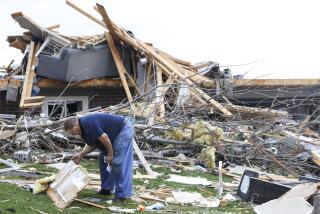Scientistâs video, radar track birth of Oklahoma tornado [VIDEO]
Mondayâs killer twister in Moore, Okla., intensified unusually rapidly, said a tornado researcher who tracked the storm from a perch about five miles away.
âOne thing that really surprised me was how quickly it developed,â said Robin Tanamachi, a postdoctoral researcher at the National Severe Storms Laboratory in Norman, Okla. âIt went from being a benign-looking blip to a supercell in 10 to 15 minutes. All the ingredients were there at the right time.â
On Monday, Tanamachi, who specializes in using radar to build computer simulations of severe storms and blogs at Tornatrix.net, was gathering data from radar equipment positioned just north of Norman, a noted center for U.S. storm research. Keeping an eye on the radar signals, she watched as a supercell thunderstorm began to develop.
PHOTOS: Oklahoma tornado from space
She scanned the storm every 60 to 90 seconds and paid attention to details like the size of water droplets, enabling her to tell that it was still in an early stage of life and was âingesting moist air.â
âThatâs usually the fuel source for a tornado,â she added.
Once Tanamachi began noticing telltale signs of a twister in the data â a âhook echo,â which indicates rotation, and a âreflectivity ball,â which suggests that a storm is churning up debris â she looked out her window and saw the tornado forming to the north. There was already a camera in place in her window. She zoomed in on the giant funnel cloud and filmed it as it passed. (You can watch her video above.)
âI knew which direction it was moving, since I had the radar data,â she said. âI felt it was safe to continue.â
Tanamachi said that sheâd like to use the data she collected Monday â in addition to data from at least three other radars that were trained on the storm â to ârecreate the storm inside a computer.â
By doing so, she said, âwe can possibly deduce things about how quickly it intensified and how quickly it ramped up to an EF-5.â (The National Weather Service in Norman said on Tuesday afternoon that damage survey crews had found at least one area of EF-5 damage.
âExploring exactly what factors controlled the intensification will be incredibly important for weather forecasting in the future,â Tanamachi added.
twitter.com/LATerynbrown
Return to Science Now.







